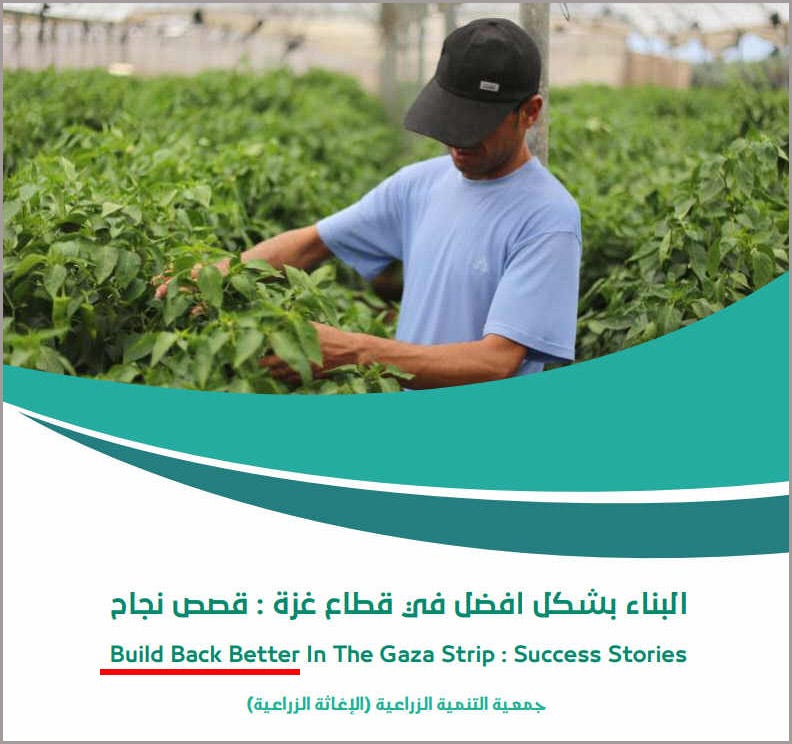GAZA STRIP Has Been a Designated "BUILD BACK BETTER" Project Since 2017
The Build Back Better motto was a 2017 Gaza Campaign to create conditions for sustainable farming. But the "Branding" of the WEF (BBB) after the Palestinian Motto is too much of a coincidence.
MAUI Now GAZA - The 666 (bbb) Solution?
Members of Benjamin Netanyahu’s Likud Party have anonymously suggested his days in office are numbered. It’s alleged that Joe Biden had said the same thing to his Israeli counterpart during the US president’s visit last month. (The Guardian)
Diakonie Katastrophenhilfe (Link)
For over 65 years, Diakonie Katastrophenhilfe has been helping people in need. We are the humanitarian aid agency of the Protestant Regional and Free Churches in Germany. Our headquarters are in Berlin.
Organisation
More than 130 employees work at Diakonie Katastrophenhilfe. The president is Rev. Dr Dagmar Pruin, the Director is Martin Kessler.
Build Back Better Stories in GAZA (2017) HERE
Diakonia Disaster Relief - Dakonia Def.
Build Back Better In The Gaza Strip : Success Stories
Download the PDF Booklet HERE
This booklet, (PDF) written in English and Arabic, introduces the story of 10 farmers, who with hard work and commitment benefitted from a project to build back better in the Gaza Strip. They tell stories of recovery and how the project helped restore their livelihoods, in many cases making them even more productive and resilient than before the war. The names in the stories are not necessarily real to protect the privacy of the farmers. The photos do not necessarily match the subjects depicted and are for illustrative purposes only.
The Build Back Better approach was utilized in a project aimed at rehabilitating the agricultural sector in the Gaza Strip implemented by PARC/Diakonie Katastrophenhilfe and funded by the German Federal Ministry of Economic Cooperation and Development (BMZ). Utilizing the Build Back Better approach for the first time in the Gaza Strip for more than two years, it was proven effective in enhancing the resilience of farmers at many levels including their size of production, income, farming and management skills and self-esteem and confidence.
Build Back Better In The Gaza Strip : Success Stories
Excerpts:
Build Back Better Approach
Introduction:
Recovery represents much more than a return to the pre-disaster state. Recovery offers impacted communities with the opportunity to not only reduce risk from the hazard that caused the disaster, but also from other anticipated hazards and conditions that might threaten the community. Recovery actions can also promote both physical and economic resilience for the impacted communities.
Usually, when a community is hit by a disaster, a speedy return to the status quo is often hoped for. But such recovery usually recreates the vulnerabilities that existed before the disaster and thus exposes communities to continuing devastation from future disasters. Thus, there is a wide understanding among donors and recovery actors, that the recovery process should not only focus on the restoration but also on the improvement of damaged facilities, livelihoods and living conditions of disaster-affected communities, including efforts to reduce disaster risk factors.
What is the Build Back Better approach?
The “Build Back Better” (BBB) approach has first emerged during the international recovery effort following the 2004 Indian Ocean Tsunami. The approach stems out from the need to improve current reconstruction and recovery practices and generate stronger and more resilient communities.
Build Back Better (BBB) is defined as a way to use the reconstruction process following a disaster to improve a community's physical, social, environmental and economic conditions and thus create a more resilient community.
The United Nations Office for Disaster Risk Reduction (UNISDR) identifies building back better as a key priority for action in the next 15 years. International research on understanding and defining BBB shows that building back better requires consideration given to three elements:
Disaster Risk Reduction: mitigating the risks from prevalent hazards
Community Recovery: Supporting the psycho-social and economic recovery of affected farmers.
Effective Implementation: conducting recovery interventions in an effective and efficient manner.
In July-August 2014, Israel launched a 51 day attack on the Gaza strip.
Aside from the human loss, the majority of the Gaza population also lost its productive assets. According to the Palestinian Federation of Industries, 419 businesses and workshops were damaged, with 128 completely destroyed. With limited activity at the commercial crossings and extensive damage to private infrastructure and other productive assets, business activities were largely paralyzed during the operation. Hostilities forced farmers and herders to abandon their lands, and resulted in substantial direct damage to Gaza's 17,000 hectares of croplands as well as much of its agricultural infrastructure, including greenhouses, irrigation systems, animal farms, fodder stocks and fishing boats. The story of Osama is an example of resilience and recovery





